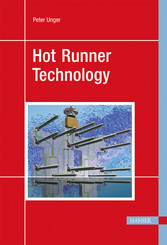Peter Unger
Hot Runner Technology
Contents
6
Preface
10
1 Introduction
12
1.1 General Aspects of Hot Runner Technology
12
1.2 Design of Hot Runner Systems and Nomenclature of Components
17
1.3 Design of Single Components Used for Hot Runner Systems
18
References for Chapter 1
19
2 Basic Aspects of Heat Technology
20
2.1 Heat Transfer
21
2.1.1 Heat Conduction
21
2.1.2 Convection
27
2.1.3 Radiation
30
2.1.4 Summary
34
2.2 Amount of Heat, Heating Capacity
35
2.3 Heat Expansion
37
References for Chapter 2
47
3 Introduction of Hot Runner Components
48
3.1 Hot Runner Manifold Block
48
3.1.1 Externally Heated Hot Runner Manifold Blocks
52
3.1.2 Internally Heated Hot Runner Manifold Blocks
57
3.1.3 Insulated Runner System
60
3.1.4 Rheological Design
63
3.2 Reflector- and Thermal Insulating Sheets, Surface Coating
67
3.3 Melt Chamber Bushing
72
3.4 Distributor Bushing
74
3.5 Spacer Disks
77
3.6 Anti-Twist Device for Hot Runner Block
89
3.7 Turn Plugs
90
3.8 Hot Runner Nozzles
93
3.8.1 General Aspects
93
3.8.2 Open Hot Runner Nozzle
94
3.8.3 Open Multiple Gate Nozzles
100
3.8.4 Shut-Off Nozzles
118
References for Chapter 3
154
4 Heating of Hot Runner Manifold Blocks
158
4.1 Cylindrical Cartridge Heater
159
4.2 Tapered Cartridge Heater
161
4.3 Threaded Cartridge Heater
162
4.4 Tubular Heater
163
4.5 Heater Plate
166
4.6 “Thick-Film”- Heating Element
168
4.7 Indirect Heating Using a Liquid Medium
169
4.8 Heat Pipe
170
4.9 Determination of Heating Capacity of an Externally Heated Hot Runner Manifold Block
171
4.9.1 Estimate of Required Heating Capacity
171
4.9.2 Numerical Determination of Heating Capacity to be Installed for the Heat-up Phase
172
References for Chapter 4
175
5 Heating of Hot Runner Nozzles
176
5.1 Cylindrical Cartridge Heater
176
5.2 Coiled Heater
177
5.3 Resistor Heater
181
5.4 Heat Pipe
184
5.5 Indirect Heating Using a Liquid Medium
185
5.6 General Remarks Regarding Internal Heating (“Conductive Heating”)
188
5.7 Indirect Heating
192
5.7.1 Thermally Conductive Torpedoes
192
5.7.2 Thermally Conductive Nozzle
197
References for Chapter 5
203
6 Measurement and Control of Temperature
204
7 Material Behavior under Mechanical Load
206
7.1 Notch Effect under Static Load
206
7.2 Notch Effect under Dynamic Load
209
References for Chapter 7
211
8 Corrosion and Wear
212
References for Chapter 8
216
9 Screw Connections and Material Selection for Elevated Temperatures
218
References for Chapter 9
221
10 Basic Aspects of Plastics Technology
222
10.1 Flow Characteristics, Viscosity, Pressure Loss
222
10.2 Thermal Stability
226
10.3 Decrease of Molecular Weight (Exemplified by PBT)
228
10.3.1 Thermal Degradation
228
10.3.2 Mechanical Degradation
230
10.3.3 Oxidative Degradation
230
10.3.4 Hydrolytic Degradation
231
References for Chapter 10
231
11 Maintenance and Storage of Hot Runner Molds
232
References for Chapter 11
233
12 Design of Special Hot Runner Systems and Hot Runner Molds
234
12.1 300-Fold Hot Runner System for the Production of Transistor Housings Made of Reinforced PBT
234
12.2 Hot Runner Manifold Block for Sandwich Molding
237
12.3 Hot Runner System with Balanced Filling Action
239
12.4 Hot Runner Nozzles for Small Center-to-Center Cavity Space
240
References for Chapter 12
242
Appendix 1: Abbreviations Used in this Book
244
Appendix 2: Conversion Factors for Units of Measure
246
Index
250
© 2009-2024 ciando GmbH
 Zu Hanser-Fachbuch.de
Zu Hanser-Fachbuch.de
 Warenkorb
Warenkorb
